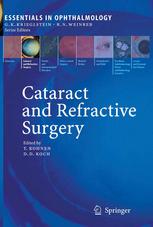

Most ebook files are in PDF format, so you can easily read them using various software such as Foxit Reader or directly on the Google Chrome browser.
Some ebook files are released by publishers in other formats such as .awz, .mobi, .epub, .fb2, etc. You may need to install specific software to read these formats on mobile/PC, such as Calibre.
Please read the tutorial at this link: https://ebookbell.com/faq
We offer FREE conversion to the popular formats you request; however, this may take some time. Therefore, right after payment, please email us, and we will try to provide the service as quickly as possible.
For some exceptional file formats or broken links (if any), please refrain from opening any disputes. Instead, email us first, and we will try to assist within a maximum of 6 hours.
EbookBell Team

0.0
0 reviewsThe topic of the second volume of the series in ''Essentials in Ophthalmology'' is cataract and refractive surgery, a realm of ophthalmic care that has undergone revolutionary changes in the past 10 years. Worldwide, the removal of the opaque crystalline lens is the most frequently performed surgical intervention in the human body, and refractive surgery encompasses an increasing array of procedures with rapidly growing surgical volumes. The goal of the editors of this book has been to provide up-to-date clinically relevant overviews and to highlight the most interesting fields of research and controversy.
The first half of the book focuses on new cataract surgical techniques and devices, including topical anaesthesia, small incision cataract surgery, modern intraocular lenses and ophthalmic viscosurgical devices. Special attention is devoted to difficult situations, such as mature, uveitic and pediatric cataracts, and to the prevention and management of complications.
The second half of the book describes current and evolving modalities - both corneal and lenticular - to correct human refractive errors. Particular emphasis is placed on topics related to quality of vision, such as wavefront technology, measuring quality of vision, and issues in pupil measurement. Many of these topics pertain also to cataract surgery, indicating the merging of technologies that is occurring in these two major ophthalmic subspecialties.